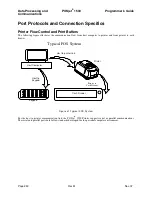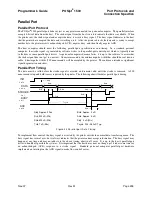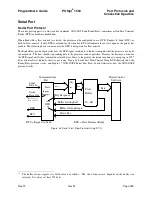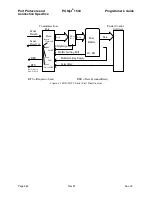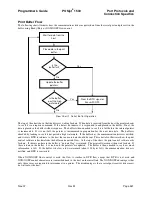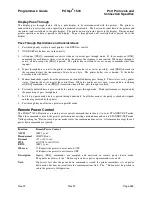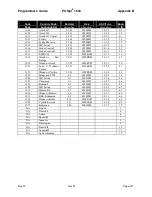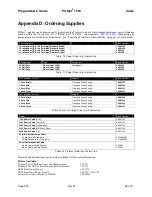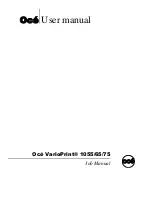
Programmer's Guide
POSjet
®
1500
Port Protocols and
Connection Specifics
Nov-07
Rev M
Page 259
Serial Port
Serial Port Protocol
The serial port supports two flow control standards, XON/XOFF and Ready/Busy (sometimes called Data Terminal
Ready (DTR) or hardware handshake).
When Ready/Busy flow control is selected, the printer can be configured to use DTR, Request to Send (RTS), or
both for flow control. If only DTR is selected for flow control, RTS will indicate the cover is open or the printer has
faulted. The following discussion assumes the DTR is being used for flow control.
The Ready/Busy protocol generally uses the DTR signal to indicate to the host computer that the printer is not ready
to accept data. The host should stop sending data to the printer as soon as possible. Because the host may not notice
the DTR signal until it has transmitted several bytes of data to the printer, the printer continues to except up to 255
25
bytes of data after it indicates that it is not ready. Figure 36 Serial Port Flow Control Using DTR illustrates how the
Ready/Busy protocol works, and Figure 37 XON/XOFF Serial Port Flow Control illustrates how the XON/XOFF
protocol works.
Serial
Communications
Port
Data
Buffer Getting Empty
Select Key
Printer Control
Software
Print
Buffer
RTS = Request to Send DTR = Data Terminal Ready
Data In
Serial
Data Out
(Not Used for
Flow Control)
DTR
RTS
DTR
Clear
Set
Inquire
Response
40 - 8K
Data
Buffer Getting Full
Data
ENQ Response
Data
ENQ
Proc.
Figure 36 Serial Port Flow Control Using DTR
25
The buffer always signals it is full before it overflows. The size of the reserve depends on the buffer size
selected. It is always at least 255 bytes.
Summary of Contents for POSJET 1500
Page 1: ...PROGRAMMER S GUIDE POSjet 1500 PN 20 03398 Rev M Nov 2007...
Page 14: ......






